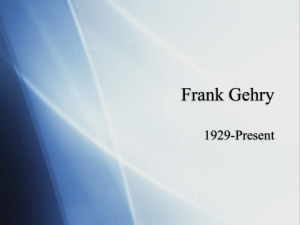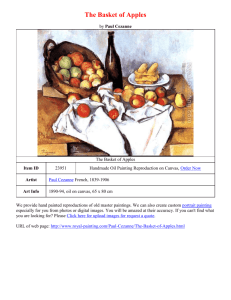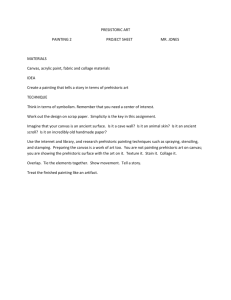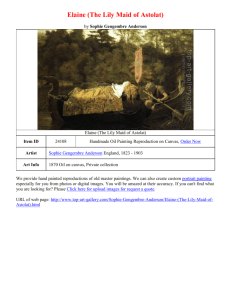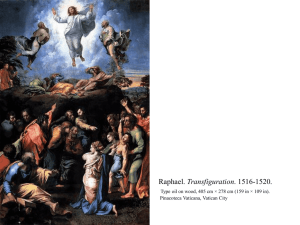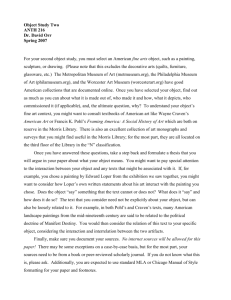Chapter 15 Decades of Change
advertisement
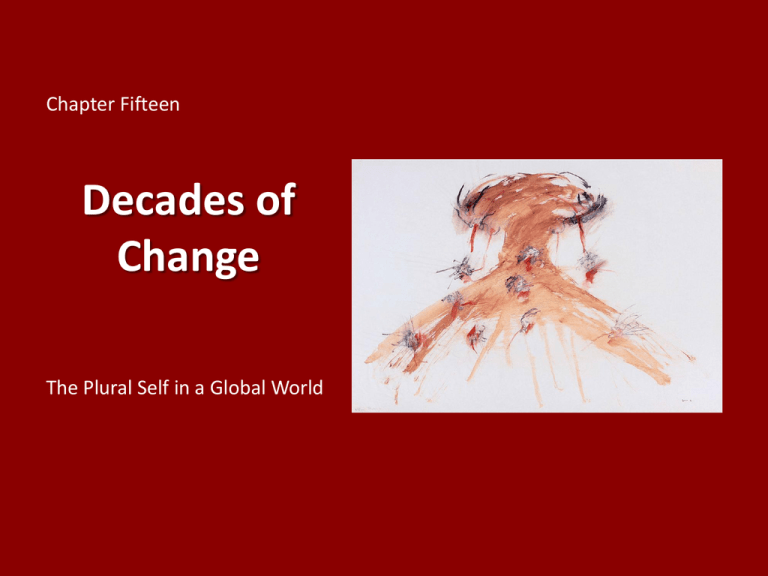
Chapter Fifteen Decades of Change The Plural Self in a Global World Prelude to War • The causes of World War II can be traced to the rise of fascism in Europe, itself attributable to the worldwide economic downturn caused by the Great Depression of the 1930s • In Germany, Hitler felt that the forces of modernity were determined to destroy the German state, specifically under the leadership of Jewish intellectuals • The Fascist ideologies that dominated Hitler’s Germany and Italy under Benito Mussolini spread to Spain by the mid-1930s, resulting in major uprisings, strikes, and full jails Pablo Picasso, Guernica Oil on canvas, 11' 5½" 25' 15¼", 1937 On April 26, 1937, a German air-force squadron bombed the town of Guernica, in northern Spain. Picasso’s painting commemorating the tragedy would become the international symbol of the horrors of war and the fight against totalitarianism. Existentialism • The Holocaust and the devastation at Hiroshima and Nagasaki dramatically increased the profound pessimism that had gripped Europeans ever since the turn of the century. How could human beings exist with the knowledge of what human beings could do? • French philosopher Jean-Paul Sartre argued for what he termed existentialism. Humans must define their own essence (who they are) through their existential being (what they do) • For Sartre, there is no meaning to existence, no eternal truth to discover. The only certainty is death Theater of the Absurd • Sartre’s play No Exit was the first example of what in the 1960s became known as the Theater of the Absurd • Among its chief proponents were Samuel Beckett, Eugène Ionesco, Jean Genet, Harold Pinter, Edward Albee, and Tom Stoppard • All of these playwrights share a common existential sense of the absurd plus, ironically, a sense that language is a barrier to communication, that speech is almost futile, and that we are condemned to isolation and alienation Action Painting • Due to a style that came to be known as abstraction expressionism, after the war New York, not Paris, became the center of the art world • American artist Jackson Pollack developed “action paintings,” in which the canvas became “an arena in which to act” • Pollack would drip, pour, and splash paint over the surface of the canvas, determining the top and bottom of the piece only after the process was complete • The result was a galactic sense of space Jackson Pollock, Number 27 Oil on canvas, 4‘ 1" 8‘ 10", 1950 With works such as this one, Pollack busted our idea of a picture all to hell. "Pollock's New Painting Technique“ Video will play automatically. From Jackson Pollock and Mark Rothko: Icons of Abstract Expressionism (length: 3:03). Item #9125 William de Kooning, Excavation Oil on canvas, 6' 8" 8' 4¼", 1950 • According to de Kooning, “Every so often a painter has to destroy painting” • Excavation is a complex organization of cream-colored forms that lead from one to another • His primary concern is the relation of the individual to his or her environment Color-Field Painting • Large paintings of enveloping color characterize another approach to abstract expressionism, a more meditative and quiet painting • The scale of these paintings is intentionally large • Green on Blue (oil on canvas, 7' 5¼" 5' 3¼", 1956) by Mark Rothko exemplifies this idea The Aesthetics of Chance • Composer John Cage and artist Robert Rauschenberg included diverse and often random elements in their creations • Cage and Rauschenberg, with Merce Cunningham, collaborated in artistic expressions, which, while simultaneous, were not planned or coordinated in advance • Alan Kaprow expanded on the concept with multimedia events called Happenings that increasingly included audience involvement Mass Media and the Culture of Consumption • The 1950s had been an era of unprecedented prosperity in the United States • Walt Disney opened Disneyland, sales of household products exploded, new products proliferated, charge cards were introduced, and fast-food chains opened their doors • Television played a key role in marketing these products • Media, popular sociologist Marshall McLuhan wrote, “create a society of desire—the desire to possess and consume what we do not have” Pop Art • In the early 1960s, especially in New York, a number of artists created a “realist” art that represented reality in terms of media—advertising, television, comic strips—the imagery of mass culture • James Rosenquist, Andy Warhol, Claes Oldenberg, and Roy Lichtenstein were among the first to present literal depictions of consumer products as legitimate art • Even as the paintings debunked the idea of originality, their literalness redefined the American landscape as the visual equivalent of the supermarket aisle Andy Warhol Campbell’s Soup Cans Marilyn Diptych 1962 1962 Roy Lichtenstein, Oh, Jeff . . . I Love You, Too . . . But . . . . Oil on magma on canvas, 4' 4', 1964 • “Feeling” in popular culture is as “canned” as Campbell’s soup • “Love” is emptied of real meaning as the real weight of the message is carried by the final “But . . . .” • The large size of this painting mirrors the Hollywood screen and the texture of the common billboard The Struggle for Civil Rights • In 1954, the U.S. Supreme Court ruled that racially segregated schools violate the Constitution. But when 9 African American students enrolled at Little Rock Central High School in Arkansas in the fall of 1957, they were turned away by the state’s National Guard • By April 1963, the focal point of racial tension and strife had shifted to Birmingham, Alabama, which in protest over desegregation orders closed its parks and public golf courses and halted distribution of food normally given to the city’s needy families • Groups of protestors descended on the city’s downtown to picket businesses that continued to maintain “separate but equal” policies and to take seats at “whites only” lunch counters Martin Luther King, Jr. • Led by the Reverend Martin Luther King, Jr., the Southern Christian Leadership Conference (SCLC) joined in the Birmingham protests • On April 6, 50 marchers were arrested. The next day, 600 marchers gathered, and the Birmingham police confronted them with clubs, attack dogs, and the fire department’s new water hoses, which, they bragged, could rip the bark off a tree • On April 12, King was taken into custody and placed in solitary confinement in the Birmingham jail The Harlem Renaissance • The Great Migration, as it was later called, of blacks out of the South at the outbreak of World War I led to a dynamic new cultural center of creative expression in Harlem • Poet Langston Hughes, who had lived in Paris for a while seeking a freedom he could not find at home, became one of the most powerful voices in Harlem • Jazz, which had established itself as the music of African Americans, by the end of the 1920s was the American music, and it was almost as popular in Paris and Berlin as it was in New York, Chicago, and New Orleans The Feminist Movement • The feminist movement, like the antiwar and civil rights movements, came into its own in the early 1960s. Due to “the Pill,” women gained control over their reproductive functions and began to express the sexual freedom that men had always taken for granted • Betty Friedan published The Feminine Mystique in 1963, in which she rejects modern American society’s cultural construction of a women • Anne Sexton, Sylvia Plath, and Adrienne Rich explore the existential concept of women in their poetry • Real change, though, was slow in coming Guerrilla Girls, Do women have to be naked to get into the Met. Museum? Poster, 1989 Postmodernism • In 1966, architect Robert Venturi issued a “Gentle Manifesto” which offered his criteria for a new eclectic approach to architecture that abandoned the clean and simple geometrics • Venuturi and others championed an architecture that would “embody the difficult unity of inclusion rather than the easy unity of exclusion” • The collision of styles and forms epitomized by Las Vegas has come to be called postmodernism The Architecture of Frank Gehry • The Los Angeles home of Frank Gehry, perhaps the dean of postmodern architecture, is a new structure surrounding an old one • Gehry established a tension between the two with differing materials and approaches Guggenheim Museum Bilbao • Gehry’s sculptural use of materials has continued throughout his career, culminating in his design for the Guggenheim Museum in Bilbao, Spain • Sculptural in concept, the museum does not blend in to the old town and its countryside in any way. But its postmodern spirit makes Bilbao a more interesting city • The design has been successful, although there were fears that the building itself would detract from the artwork displayed within Frank Gehry, Guggenheim Museum Bilbao 1997 Frank Gehry, Guggenheim Museum Bilbao 1997 East/West, North/South • Western culture has transformed other cultures • Asian cultures are particularly challenging to postmodern architects because their cities possess a much greater mix of functions. Tall buildings rise in the midst of smaller residential structures • Rem Koolhaas, a leading urban scholar and professor at Harvard University, has designed one of the most intriguing new projects in Asia—the headquarters of a Chinese television network, completed for the 2008 Beijing Olympics Rem Koolhaus, New Headquarters, Central Chinese Television CCTV Yokinori Yanagi, America Ants, colored sand, plastic boxes, plastic tubes, 1994 • America is an image of international cross-fertilization • Japanese artist Yanagi filled each box with colored sand in the pattern of a national flag from the nations of North and South America • Ants introduced into the system immediately began carrying sand between flags, transforming and corrupting their original designs Yasumasa Morimura, Portrait (Twins) Color photograph, 6' 13½" 10', 1988 • Traditionally insular Japan has recognized artistically the collision of cultures, of traditional and contemporary worlds • The complex relationship between East and West and between male and female is explored in Yasamasu Morimura’s Portrait (Twins) of 1988, which echoes Manet’s Olympia Chris Ofili, The Holy Virgin Mary Paper collage, oil paint, glitter, polyester resin, map pins, and elephant dung on linen 8' 6‘, 1996 • British-born Nigerian artist Ofili portrays the Virgin as a black woman, and surrounding her are putti with bare bottoms and genitalia cut out of pornographic magazines • Two balls of elephant dung support the painting, and a third clump defines one of her breasts. In Yoruba culture, genitalia and dung are associated with fertility Shahzia Sikander, Pleasure Pillars Watercolor, dry pigment, vegetable color, tea, and ink, 12" 10", 2001 • Pakistani painter Sikander explores the tensions inherent in Islam’s encounter with the Western world • She portrays herself as a powerful ram surrounded by images of East and West • At the top, a modern fighter jet roars by
